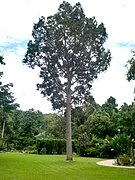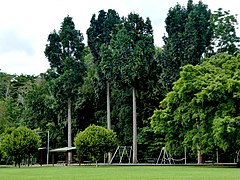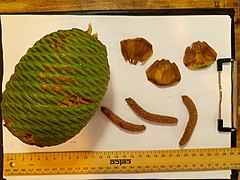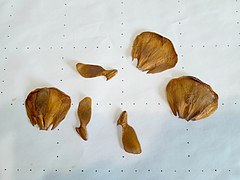Agathis robusta
| Agathis robusta | |
|---|---|

| |
| Scientific classification | |
| Kingdom: | Plantae |
| Clade: | Tracheophytes |
| Clade: | Gymnospermae |
| Division: | Pinophyta |
| Class: | Pinopsida |
| Order: | Araucariales |
| Family: | Araucariaceae |
| Genus: | Agathis |
| Species: | A. robusta
|
| Binomial name | |
| Agathis robusta | |
| Subspecies[4] | |
| |

| |
| Synonyms[4] | |
|
Dammara robusta C.Moore ex F.Muell. (1860) | |
Agathis robusta, commonly known as Dundathu pine, kauri pine, Queensland kauri (pine), Australian kauri (pine) or smooth-barked kauri, is a coniferous tree in the family Araucariaceae. Although some common names use the word 'pine' it is not a true pine, having leaves rather than needles. It has a disjunct distribution, occurring in Papua New Guinea and two locations in Queensland, Australia.
Description
[edit]Agathis robusta is a large evergreen tree with a straight cylindrical trunk, which can often reach a height of 30–40 m (98–131 ft), and occasionally 50 m (160 ft).[5][6][7] The trunk is usually about 1.2 m (3 ft 11 in) diameter at breast height (DBH), but occasionally may reach 3 m (9.8 ft).[5] The bark is orange-brown to grey-brown, smooth, but shedding in large flakes.[6][7][8][9]
The linear-elliptic leaves are up to 13 cm (5.1 in) long and 4 cm (1.6 in) wide, with numerous fine parallel veins and no midrib.[7][8] They are carried on petioles measuring 3 to 10 mm (0.1 to 0.4 in) and are arranged in opposite pairs (rarely whorls of three) on the stem.[6][7][8]
The globose, green seed cones measure 8–13 cm (3.1–5.1 in) diameter with up to 440 scales, and mature in 18–20 months after pollination.[6][7][8] They disintegrate at maturity to release the seeds. The male (pollen) cones are cylindrical, 5–10 cm (2.0–3.9 in) long and 9 mm (0.4 in) diameter.[6][7][8]
Taxonomy
[edit]The Queensland kauri was first described as Dammara robusta in 1859 by the German-born Australian botanist Ferdinand von Mueller and published in the journal Quarterly Journal and Transactions of the Pharmaceutical Society of Victoria. In 1883 the Colonial Botanist of Queensland Frederick Manson Bailey published a paper in which he gave the species its current binomial name Agathis robusta.[3][4]
Subspecies
[edit]There are two recognised subspecies as of January 2023[update], namely:
- Agathis robusta subsp. nesophila Whitmore (syn. Agathis spathulata de Laub.[10]), which is restricted to eastern New Guinea and New Britain[11]
- Agathis robusta ssp. robusta, the autonymous subspecies, which is native to New Guinea and Queensland.[4]
Etymology
[edit]The genus name Agathis is from the Ancient Greek word ἀγαθίς 'ball of thread', a reference to the appearance of the female cones (seed cones).[5][9] The species epithet is derived from the Latin word rōbustus meaning 'robust'.[9]
Distribution and habitat
[edit]Agathis robusta occurs in three distinct locations — a southern population in southeast Queensland in the regions around Gympie, Maryborough, and K'gari (Fraser Island); another population in northeast Queensland in the regions from Ingham to Cooktown, including the Atherton Tablelands; and the third in New Guinea.[5][12] The north Queensland population was formerly recognised as Agathis palmerstonii, but is now considered to be synonymous with the southern grouping.[13]
The species grows in rainforest on well-drained soils of various types, at elevations up to 1,100 m (3,600 ft) and where the annual rainfall is between 1,100 and 1,500 mm (43 and 59 in).[5][8]
Ecology
[edit]The seeds of the Queensland kauri are eaten by sulphur-crested cockatoos (Cacatua galerita).[9]
Conservation
[edit]Agathis robusta is listed by both the Queensland Department of Environment and Science and the IUCN as least concern. However, the IUCN assessment states that the "subspecies in Papua New Guinea has been assessed as Vulnerable" due to ongoing, albeit limited, logging.[1][2]
Pests and diseases
[edit]A number of Lepidoptera species utilise the Queensland kauri as a host plant, including Agathiphaga queenslandensis, Heteropsyche poecilochroma, Leipoxais rufobrunnea, Darna nararia, Orgyia australis, Achaea janata, and Lexias dirtea.[14]
Uses
[edit]This tree produces a high quality timber, which was used for a variety of purposes, such as cabinetmaking, joinery, framing, and plywood. This led to it being heavily logged from the mid-19th century, with the result that the large stands of these trees, which were once common, are now gone, although many individual trees may still be found. Logging in north Queensland continued until the establishment of the Wet Tropics of Queensland World Heritage area in 1987.[8][5]
State-owned plantations of kauri were established in both north and south Queensland in the first half of the 20th century and met with varying degrees of success; however, today little more than 100 ha (250 acres) of plantation kauri exists.[5]
Gallery
[edit]-
Specimen in the Cairns Botanic Gardens
-
Trunk
-
Near Freshwater Ck, Cairns
-
Foliage
-
Female and male cones
-
Scales and seeds from female cone
-
Seedling
-
Harvesting kauri logs, circa 1912
References
[edit]- ^ a b "Species profile—Agathis robusta". Queensland Department of Environment and Science. Queensland Government. 2022. Retrieved 20 January 2023.
- ^ a b Farjon, A. (2013). "Agathis robusta". IUCN Red List of Threatened Species. 2013: e.T16437966A2960124. doi:10.2305/IUCN.UK.2013-1.RLTS.T16437966A2960124.en. Retrieved 19 January 2023.
- ^ a b "Agathis robusta". Australian Plant Name Index (APNI). Centre for Plant Biodiversity Research, Australian Government. Retrieved 19 January 2023.
- ^ a b c d e "Agathis robusta C.Moore ex F.Muell". Plants of the World Online. Royal Botanic Gardens, Kew. Retrieved 19 January 2023.
- ^ a b c d e f g "Araucariaceae in Queensland" (PDF). Woodworks Museum & Interpretive Centre. Retrieved 21 December 2022.
- ^ a b c d e Hill, K.D. (2020). "Agathis robusta". Flora of Australia. Australian Biological Resources Study, Department of Climate Change, the Environment and Water: Canberra. Retrieved 19 January 2023.
- ^ a b c d e f Earle, C.J. "Agathis robusta (Kauri pine) description". The Gymnosperm Databse. C.J.Earle. Retrieved 19 January 2023.
- ^ a b c d e f g F.A.Zich; B.P.M.Hyland; T.Whiffen; R.A.Kerrigan (2020). "Agathis robusta". Australian Tropical Rainforest Plants Edition 8 (RFK8). Centre for Australian National Biodiversity Research (CANBR), Australian Government. Retrieved 19 January 2023.
- ^ a b c d Cooper, Wendy; Cooper, William T. (June 2004). Fruits of the Australian Tropical Rainforest. Clifton Hill, Victoria, Australia: Nokomis Editions. p. 4. ISBN 9780958174213.
- ^ de Laubenfels, D. J. (1988). Coniferales. In van Steenis & de Wilde (eds.), Flora Malesiana 10: 337-453.
- ^ "Agathis robusta subsp. nesophila Whitmore". Plants of the World Online. Royal Botanic Gardens, Kew. Retrieved 19 January 2023.
- ^ "Search: species: Agathis robusta | Occurrence records | The Australasian Virtual Herbarium". Australasian Virtual Herbarium. Australian Government. Retrieved 19 January 2023.
- ^ Whitmore, T. C. (1980). A monograph of Agathis. Pl. Syst. Evol. 135: 41-69.
- ^ "HOSTS - a Database of the World's Lepidopteran Hostplants". Natural History Museum. The Natural History Museum, London. Archived from the original on 19 January 2023. Retrieved 19 January 2023.
External links
[edit]- View a map of historical sightings of this species at the Australasian Virtual Herbarium
- View observations of this species on iNaturalist
- View images of this species on Flickriver
- Agathis robusta at the Gymnosperm Database.
- Nature Conservation Act least concern biota
- IUCN Red List least concern species
- Agathis
- Flora of the Bismarck Archipelago
- Flora of New Guinea
- Flora of Queensland
- Trees of Australia
- Pinales of Australia
- Least concern flora of Australia
- Least concern biota of Queensland
- Plants described in 1860
- Taxa named by Ferdinand von Mueller
- Taxa named by Frederick Manson Bailey









